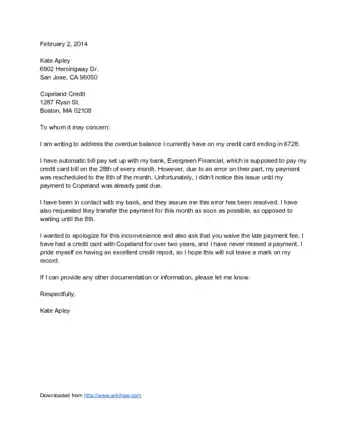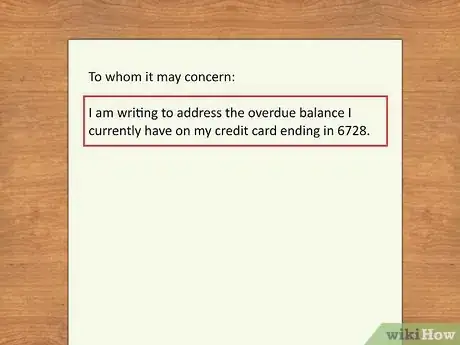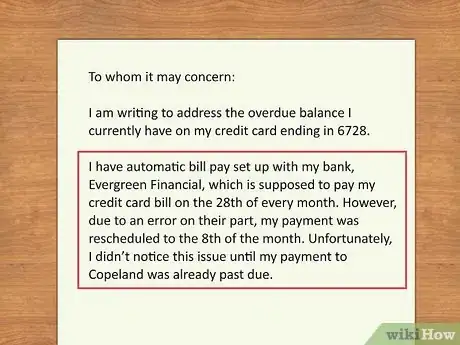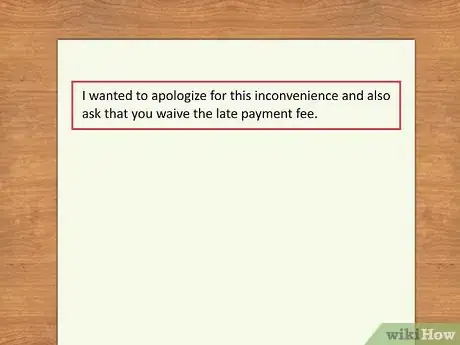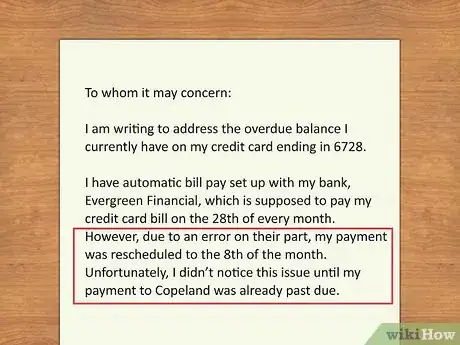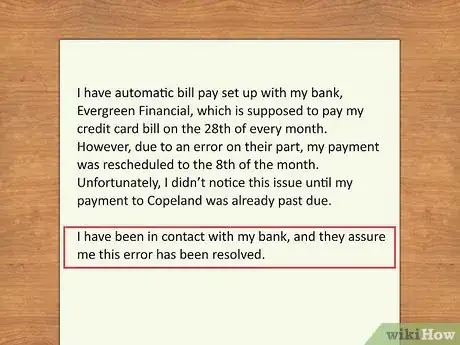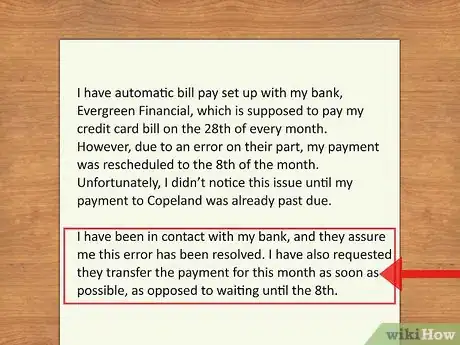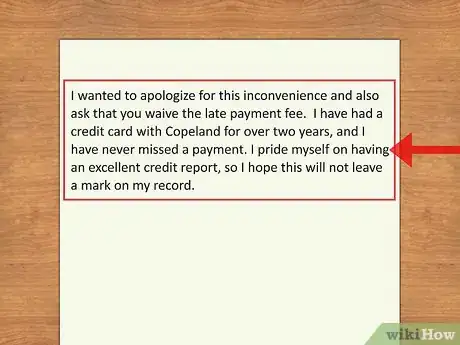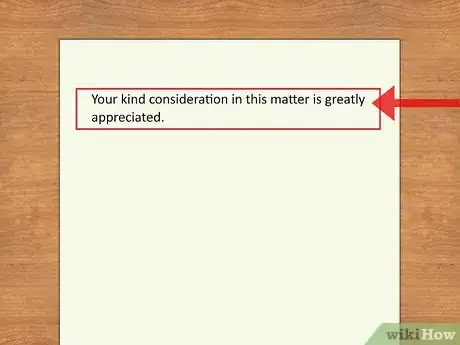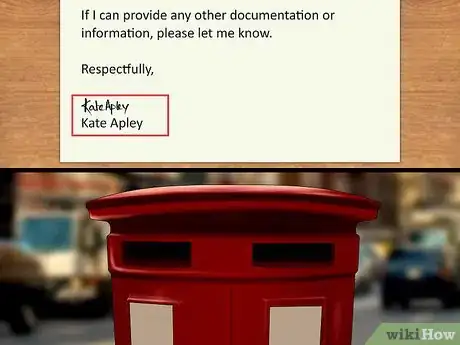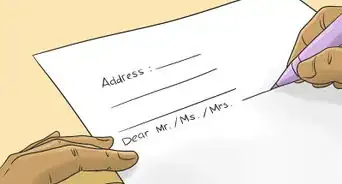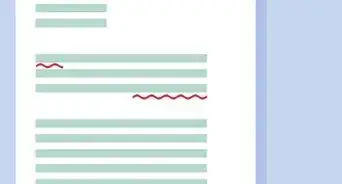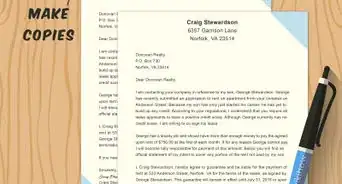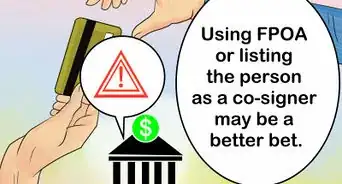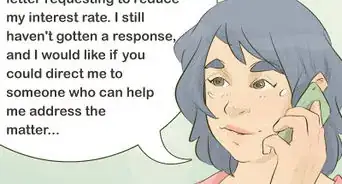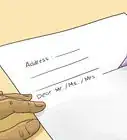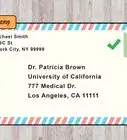This article was co-authored by wikiHow Staff. Our trained team of editors and researchers validate articles for accuracy and comprehensiveness. wikiHow's Content Management Team carefully monitors the work from our editorial staff to ensure that each article is backed by trusted research and meets our high quality standards.
This article has been viewed 228,279 times.
Learn more...
When making a payment for a bill or a loan, the best thing you can do is to pay on time, every single time. In an ideal world, this would always be the case. However, sometimes things occur that prevent you from making a payment on time. Sending a late payment letter can help to explain the issue, apologize for the delay, express your good intentions going forward, and— hopefully— avoid any penalties against you.
Steps
Sample Letter
Explaining the Issue
-
1Lay out the facts for your creditor. In other words, don’t make your creditor hunt down your bill in order to understand what you’re talking about. Right off the bat, state your name, account information, the payment amount in question, the original due date, and any other pertinent information.[1] Demonstrate to the creditor that you are well aware of the situation also and do not intend to avoid the discussion concerning the past due status. Your creditor may receive checks and letters daily, so don’t waste their time by being vague and assuming they know your particular situation.
-
2Tell them exactly what happened with your payment. If it was completely your fault, suck up your pride and tell them that. If you faced some sort of emergency or crisis, tell them that too. It’s important to be truthful and thorough.[2] If you’re genuine, they might be appreciative and take pity. Be careful not to whine while you’re explaining your predicament.
- While you should be thorough, don’t give them more information than they need. For example, they don’t need to know every gruesome detail of a medical issue, or the ins-and-outs of a messy divorce!
Advertisement -
3Apologize profusely for the inconvenience. Even if you think your late payment is no big deal, show remorse. If they think you’re nonchalant about the issue at hand, they may not be so quick to show you mercy. By apologizing and taking complete responsibility for the tardiness, you will also show them that you do not take your responsibilities lightly and you will learn from this.[3]
Stating your Plan
-
1Clarify the status of the problem that caused you to pay late. For example, if you missed a payment because you lost your job, explain your current employment status. If you had a medical emergency, explain where your health stands. It is not enough to just make the payment you missed— you need to let your creditor know that this will not be a recurring problem.[4]
-
2Explain how you will ensure timely payments moving forward. If the issue that delayed this particular payment is not rectified, explain why it will not affect you in the future. If that specific problem has been fixed, make sure you state what kinds of things you will do to prevent late payments moving forward.[5]
- For example, let’s say you are sending a payment in late because your car broke down and you had to pay to fix it. You may tell your creditor that your car is fixed, so that particular problem is eliminated. However, you need to explain why these kinds of problems won’t interfere with timely payments again. You can put money aside for unforeseen circumstances, prioritize this particular creditor in the future, etc.
-
3Elaborate on how you will get back on track with your payments. Inform the creditor about when you will be able to make the payment (in full or a partial payment). Avoid making unrealistic promises; the plan you present to your creditor needs to be one that you can follow through without difficulties. By explaining your plan, you will show that you’ve taken initiative to plan ahead and get your finances in order.[6]
Requesting Forgiveness
-
1Remind your creditor of your payment history. If you typically pay on time, remind them of that. Creditors deal with customers who pay late regularly, so it’s beneficial to note if making a late payment is out of character for you. Use your good credit history to your advantage to establish that this particular instance is not what the creditor should normally expect from you.[7]
-
2Show appreciation. No matter what you are sending in payment for, it doesn’t hurt to suck up a little. Whether you’re paying rent or a credit card bill, tell your creditor that you are grateful for the goods or services that they provide. Use this opportunity to show your loyalty to the person or company.
-
3Sign and mail the letter immediately. Send it as soon as you realize your payment will be late or that you will not be able to make the payment until a later date. Waiting until your creditor contacts you about the late payment does not increase the chances of any leniency concerning a reduction of penalties or the likelihood of the creditor not making a negative report to the credit agencies.
Community Q&A
-
QuestionShould it be handwritten or typed?
 Community AnswerYou can do whichever you prefer, but handwritten may come off as more sincere and genuine.
Community AnswerYou can do whichever you prefer, but handwritten may come off as more sincere and genuine.
Things You'll Need
- Computer
- Printer
- Paper
- Envelope
- Stamp
References
- ↑ https://www.linkedin.com/pulse/writing-perfect-letter-explanation-dan-lord
- ↑ https://www.nerdwallet.com/blog/finance/late-payments-removed-credit-report-sample-goodwill-letter/
- ↑ http://www.sample-resignation-letters.com/writing-a-letter-explaining-late-payments-with-sample.html
- ↑ https://www.nerdwallet.com/blog/finance/late-payments-removed-credit-report-sample-goodwill-letter/
- ↑ https://www.indeed.com/career-advice/resumes-cover-letters/explanation-letter
- ↑ https://www.indeed.com/career-advice/resumes-cover-letters/explanation-letter
- ↑ https://www.nerdwallet.com/blog/finance/late-payments-removed-credit-report-sample-goodwill-letter/
About This Article
If you’re not able to make a payment on time, write a late payment letter to explain the issue and apologize for the delay. Mention specifically what the payment was for to make it clear to your creditor. Then, explain why you’re not able to make the payment on time and apologize for the inconvenience. You should also tell them when you’ll be able to make the payment and ensure them that your future payments will be on time. Finish your letter by thanking them for the goods or services they provide. Mail the letter immediately so you can get it to your creditor as soon as possible. This may help you to avoid a late penalty, but there's no guarantee. For a sample late payment letter, read on!
